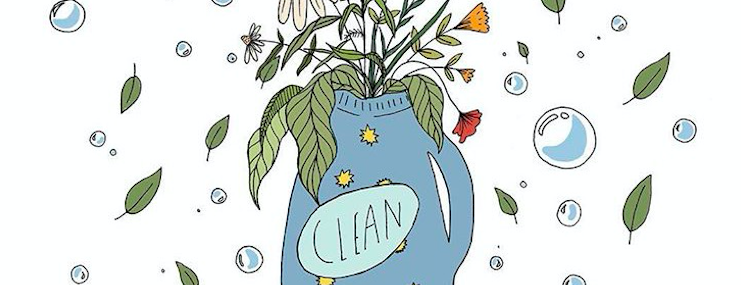In my last story on sustainable dry cleaning, I promised you a follow-up with tips on home care and shopping habits to rescue you from your fussy garments.
Because, not all of us have access to a posh laundry lounge where the beer takes the edge off our grunt work. Portland, I’m talking to you.

Better cleaning starts with better shopping
The best advice I can give you is to start at the source – your clothing labels. Before you buy take note when clothes say they are ‘dry clean only’ and opt for alternatives when available. If your label says simply, ‘dry clean’ you can also consider home cleaning depending on the material.
You may be ready to invest in an ethical silk dress, or bamboo boxers for men, but there’s more to consider than the one-time purchase of your garment. Most of the environmental impact of clothing – 70-80 percent to be specific – occurs during the cleaning phase. If you think through your purchase before you buy, it can make big impact on sustainability.
Before you buy you can ask yourself questions like:
- Can I commit to the cost required for regular eco-conscious specialty cleaning?
- Is an eco-conscious cleaner accessible to me (find one)?
- Do I have an alternative way to clean this garment cheaper at home?
- And, if so, will I realistically dedicate the time and effort required?
Get to know you cleaner
With textile technology today, you should still be able to get a luxury look without tons of embellishment or complicated mixes of textiles. If you do decide to go with the more luxurious, dry clean only option be sure to ask yourself if the garment’s durability will outweigh the need for specialized cleaning. (aka – is it worth it?)
If you make the leap to ‘specialty cleaning’ go talk to the owner of your local shop. If he/she is open about their process and use specific names for solvents and chemicals that’s a good sign. Their staff should also be trained and conversant in the process, if they’re not, it’s a sign of bad management. Don’t let them use clever marketing buzzwords on you!
Think of your clothes as part of a life cycle
Assuming I’ve already swayed you to purchase ethical clothing, then you know the suppliers, manufacturers, and designers who made your garments went through significant strides to get them to you. Can you hold up your end of the deal as a consumer by giving your garments the care they need to ensure longevity?
Perfect your home care
If your determine your ‘dry clean’ garment will hold up to home care, here are some tips you can use before you try water submersion. Don’t try these on hides of any kind!
Air it.
If sun is an option, sometimes it soaks up the stink. Try this first. But please, read on if the stink persists, I’m not advocating that you become a social outcast here.
Spray it.
Save your liver the trouble and spray that stink with vodka! Alcohol kills bacteria the same way it kills your next day plans. We’ve all had that experience at some point or another in our lives, haven’t we? In fact, many of us probably had it earlier than others, especially if you used a legit fake id to buy this beverage at a bar or local supermarket before you were old enough. But as times have changed, you can now use it as a cleaning product as well as a drinkable concoction. Warning, give you garment a day in the fresh air before wearing or someone might mistake your newfound vodka Teetotalism with a terrible vice upon first whiff.
Steam it.
I’ve added white vinegar or baking soda to my steamer before and sometimes that helps.
Brush it.
I recommend the brushes for salon use to lift the pesky oils away. You can spray a little water or baking soda mixture as you go.
Kill it.
If you home is infested with clothes moths, they’re going to be leaving their dirt all over your clothes, even after washing them. You’re going to need https://www.pestcontrolexperts.com/local/alabama/dothan/ or a service from a similar site to eradictate the moths from your home, otherwise they’re going to keep getting dirt on everything.
Wash it.
Okay, if it’s really dirty, none of the above options will really work. Don’t be shy of water. It probably won’t ruin your dry clean only clothes (like I mention above). If it’s silk, wool or cotton, it’s fair game for submersion. Just make sure it doesn’t have fancy beading or detailing. You’ll need a sink, biodegradable detergent (I like biokleen), cold water and a large towel for drying (NEVER wring out nice garments.) Follow the steps here.
The future
While researching this piece I came across a German system that uses a biodegradable solvent called K4 that might hit the states. My fingers are crossed. Also, pay attention to the conversation happening around how your synthetic garments break down during the wash cycle and pollute the ocean (The Guardian). You can keep this in mind and opt for natural fibers (no nylons, polys, rayons, spandex) that won’t break down in micro particles.
Feature image via Spin Laundry Instagram.




